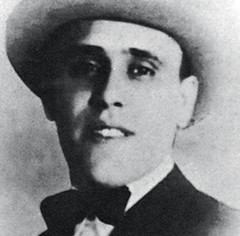
PREV ARTICLE
NEXT ARTICLE
FULL ISSUE
PREV FULL ISSUE
ALVES REIS: THE MAN WHO STOLE PORTUGAL
I'm not one to make lists, but if I were to decide to rank my favorite counterfeiters, at the top would be Alves Reis, profiled in the book The Man Who Stole Portugal (Murray Bloom, 1966). He very nearly pulled off the most audacious scheme in world history, becoming vastly wealthy in the process and nearly bankrupting a sovereign government when his work unraveled. This article by Zachary Habermas on CoinWeek (originally published at www.pmgnotes.com on 7/1/2015) doesn't reference that fascinating book, but it provides a great overview of what must be the greatest swindle of all time.
-Editor
However, the payoff was immense. While in jail for embezzlement in 1925 he concocted a scheme that would later be known as the Portuguese Banknote Crisis. He and a few associates forged a document in the name of the Central Bank of Portugal, the institution responsible for creating the supply of Portuguese currency, which authorized the printing of a run of banknotes. Reis took the forged documents to William Waterlow, of the printing company Waterlow &Sons, and convinced the company to print the notes. Since Waterlow &Sons had the original plates of the notes they were being asked to print, the notes printed for Reis were literally indistinguishable from the authorize prints. When Waterlow realized that the serial numbers printed were already used in previous runs, they contacted the bank. Their contact, unfortunately, was Reis, who reassured them that it was okay.

Portugal 500 escudos, reverse Reis managed to have 200,000 copies of the above 500 escudos (the currency used at the time) note printed, totaling 100 million escudos face value. This was equal to .88% of Portugal’s GDP at the time. To put that in perspective, if this was done in the US today Reis would have received $150 billion. Reis would then use the currency to buy gold-backed foreign currencies and trade in the 500 escudo bills for small denominations. Reis would go on to buy land, jewelry, clothing and businesses throughout Portugal and Angola, creating an economic mini-boom. Eventually Reis was discovered. His bank, Banco de Angola de Metropole, was investigated for illegally buying foreign-backed currencies. While under investigation, their reserves of the illegal 500 escudo bills were searched. By chance, the authorities managed to find notes with the same serial number, meaning they were illegal duplicates. Had it not been for that, there would have been no proof of counterfeiting. Reis and his associates were aware of an arrest warrant out for them and while some managed to escape, Reis chose to face the charges and defend himself. The quality of his forged documents was so good that some believed that the whole plot was devised by the central bank, delaying the trial for five years. Reis was eventually sentenced to 20 years in prison, which he served in its entirety. During his sentence he would often ask why the notes he printed were deemed illegitimate despite being no different than the genuine ones. Upon his release he was offered a job, oddly enough, as an employee in a bank. However, he refused the job and lived a quiet and modest life until his death by a heart attack in 1955.
It takes continent-sized cajones to pull off a deal like that. So who among our readers has a pair? A pair of identically-numbered 500 Escudo notes, I mean. With two indistinguishable notes of the same serial number, at least one of them has to be one of the famous Reis "counterfeits". Or is it a counterfeit? An unauthorized issue perhaps, but a counterfeit? Interesting situation...
-Editor
To read the complete article, see:
The Numismatic Bibliomania Society is a non-profit organization promoting numismatic literature. See our web site at coinbooks.org. To submit items for publication in The E-Sylum, write to the Editor at this address: whomren@gmail.com To subscribe go to: https://my.binhost.com/lists/listinfo/esylum All Rights Reserved. NBS Home Page Contact the NBS webmaster 
|
